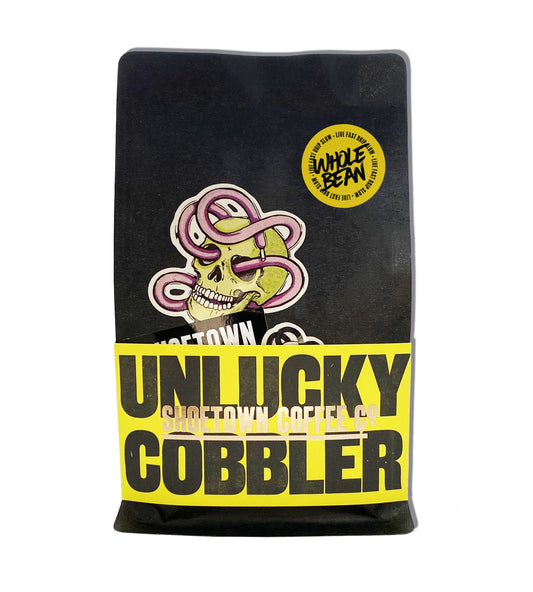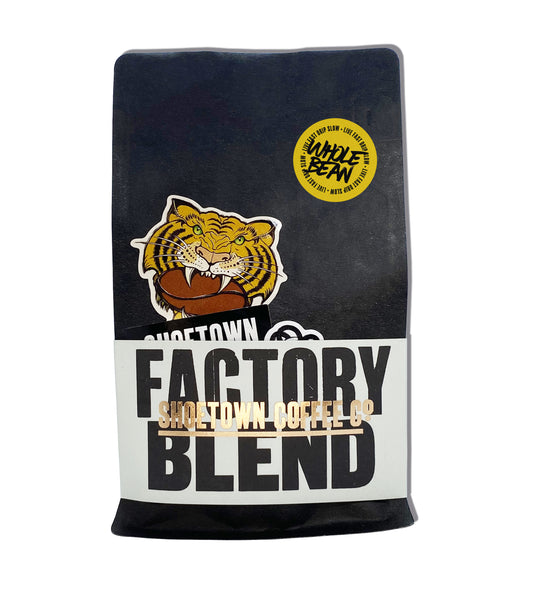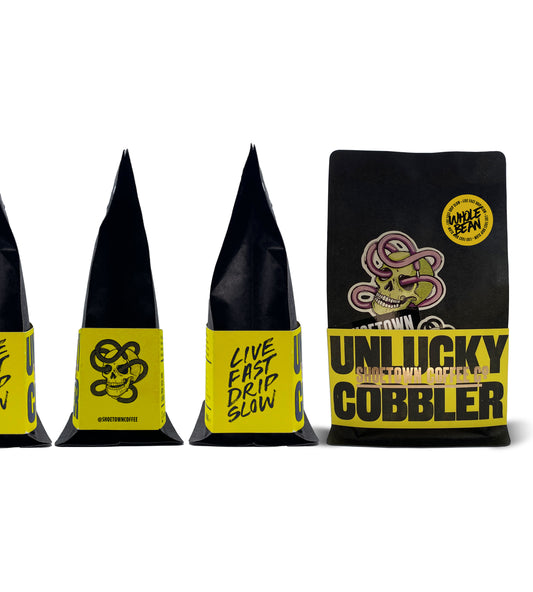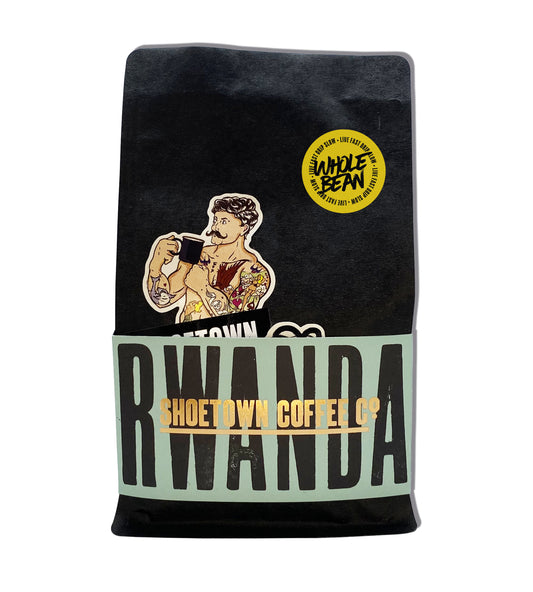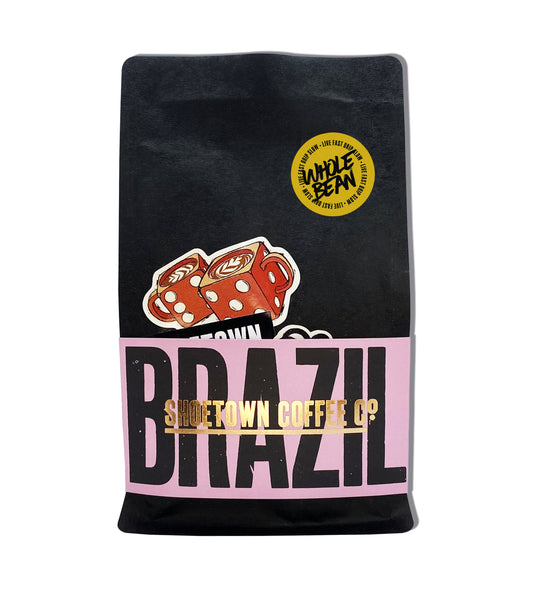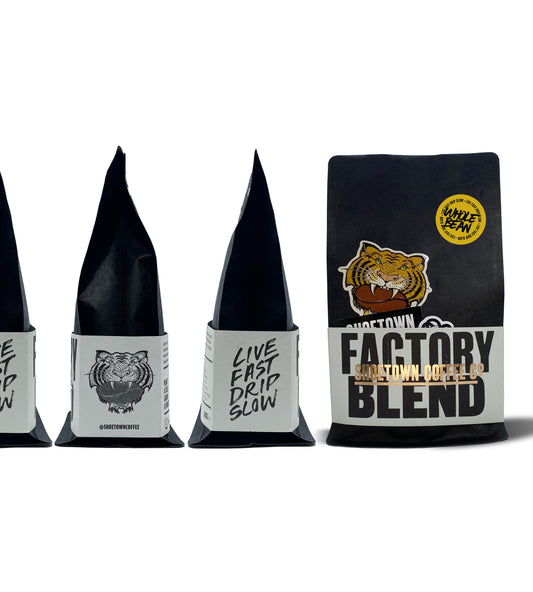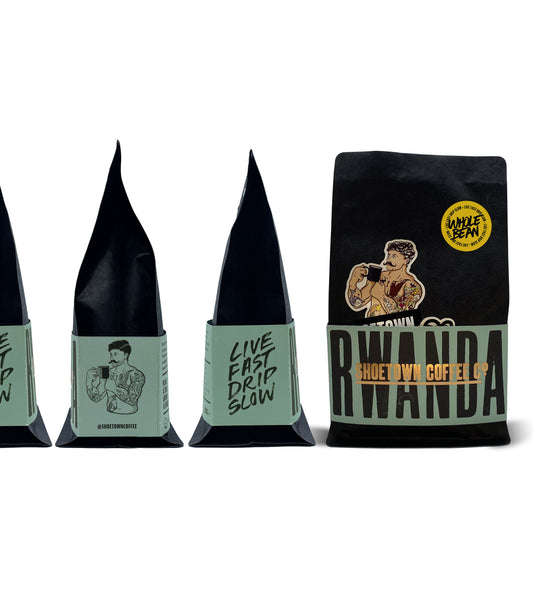Coffee Basics: Sourcing

Coffee Basics: Sourcing
BY SHOETOWN COFFEE PUBLISHED SAT 23 MAR 25
Producing great coffee isn’t a fast process, it’s not an easy process, and it certainly isn’t a cheap process. We know growing exceptional coffees requires more work and we never take this for granted. Producers tirelessly tend to their coffee trees, hand-picking cherries at perfect ripeness, carefully processing the beans, and allowing them to develop over time. Their skill, craftsmanship, and attention to detail are the difference between mediocre coffee and high-grade specialty coffees.
The coffee industry can be split into two main areas: commodity coffee (or what we like to call corporate coffee) and specialty coffee. Specialty coffee is defined by quality and flavour, carefully graded on a 100-point scale by certified Q Graders, so you know exactly what you’re getting. Factors such as origin, microclimate, soil composition, and post-harvest processing play a huge role in determining a coffee’s flavour and quality.
On the opposite end of the scale, corporate coffee is purely traded on price, with little concern for where it’s grown, how it’s harvested, or how it’s processed. Multinational brands work hard to keep coffee prices low which sadly comes at a human cost, someone in that coffees journey will need to struggle to keep that coffee cheap. Cheap coffee is something that shouldn’t be celebrated. Ever. Unfortunately though, corporate coffee has shaped how the world sees coffee—but we’re here to change that.
When we’re looking to introduce a new coffee, it has to tick a lot of boxes. To be labeled speciality coffee, it must score 80+ on the SCA (Specialty Coffee Association) and CQI (Coffee Quality Institute) scale and have no defects in the green coffee or final cup. It also has to be a win-win for both us and the producers. We focus on building partnerships, working hand-in-hand with carefully selected suppliers who are dedicated to working directly with the producers—many of them small-scale producers—making sure they have been well paid for the coffee they grow, paying above and beyond the fair trade base price to ensure fair and sustainable relationships. After all, without the producers, we’re nothing.
Where Our Coffee Comes From
Every coffee-growing region has its own unique climate, altitude, and processing traditions, which all play an important part in shaping the final cup. Here’s a look at some of our favourite origins—Brazil, Rwanda, and Colombia. We’ve put together a bit of a cheat sheet to the types of coffee they produce, processing styles, and what to expect from each one.
Brazil is the largest coffee producer in the world, responsible for about a third of global coffee production. Coffee farming here spans vast regions, from low-altitude robusta farms to high-altitude speciality microlots scoring 90+ points. With a hot, humid climate and rich soil, Brazil is home to an incredibly diverse coffee scene, producing everything from mass-market blends to award-winning speciality lots.
🗺️ Key Coffee-Growing Regions:
- Minas Gerais – The heart of Brazilian coffee, producing both commercial and high-quality speciality coffees.
- Espírito Santo – The country’s second largest coffee growing region and the biggest for robusta coffee production.
- São Paulo – Produces high-quality coffee and is home to the Port of Santos, Brazil’s main coffee export hub.
🌱 How It’s Grown & Processed:
- 80% Arabica, 20% Robusta – Brazil grows both Arabica and Robusta, but the bulk is Arabica. Quality can range from low-altitude Robusta for instant coffee to high-altitude experimental microlots that score 90+
- Natural & Pulped-Natural Processing – Brazil is well known for producing Natural and Pulped Natural coffee but they also produce some washed coffee too, though they’re less common.
- Improved Traceability – Brazil used to blend coffee into huge, anonymous lots, but now, thanks to direct sourcing from farms like Fazenda Inhame, we can now track coffee back to its specific farm and producer.
☕️ What It Tastes Like:
- Natural: Bold and fruity with notes of dried fruit, nuts, and chocolate.
- Pulped-Natural: Smooth and sweet with caramel, nutty tones, and mild fruit hints.
Brazilian coffee is versatile, accessible, and constantly evolving. It’s a go-to origin for reliable, easy-drinking coffees with smooth chocolate and nutty notes, but it’s also full of surprises—especially as more producers experiment with processing methods and focus on quality and traceability.
With its combination of scale, innovation, and tradition, Brazil continues to be one of the most exciting and dependable origins in the coffee world. Whether you’re brewing a comforting morning cup or hunting down a rare microlot with vibrant fruit and floral notes, Brazil offers something for every kind of coffee drinker.
Rwanda may be a small country, but its specialty coffee is off the charts. With rich volcanic soil, high altitudes, and a growing culture rooted in community-driven farming, Rwandan coffee is known for its bright, complex character. Nearly all the coffee grown here comes from smallhold producers, each with just a few hundred trees, with many contributing to cooperatives that deliver their coffee to centralized washing stations.
🗺️ Key Coffee-Growing Regions:
- Western Province (Lake Kivu) – High-altitude farms near Lake Kivu produce bright, citrusy coffees with great clarity.
- Southern Province (Huye, Nyamagabe) – Known for clean, complex profiles with notes of stone fruit, florals, and black tea.
- Northern Province (Gakenke, Rulindo) – Offers well-balanced coffees with juicy acidity and floral aromatics.
- Eastern Province (Ngoma, Rwamagana) – An emerging region with growing investment in quality-driven coffee production.
🌱 How It’s Grown & Processed:
- Arabica – Red Bourbon – Most Rwandan coffee is Red Bourbon, a variety known for its sweetness and clarity. Grown at 1,600–2,000m above sea level, the high elevation and volcanic soil give the beans excellent growing conditions.
- Washed & Natural Process – Washed processing is the most common, often involving wet fermentation, soaking, and drying on raised beds. Many producers, like those at Bwishaza and Liza washing stations, also produce natural lots, which are dried with the fruit intact for more fruity flavour profiles.
- Community Focused – Rwanda’s coffee industry is built on strong community collaboration. Many smallholder farmers deliver their coffee to cooperative-run or privately owned washing stations, where quality and transparency are key. This model not only supports consistency and traceability, but also helps ensure that producers are paid well above Fairtrade prices for their high-quality coffee
☕️ What It Tastes Like:
- Washed: Orange, caramel, brown sugar, black tea, and citrus.
- Natural: Juicy berry flavours like strawberry and raspberry.
Rwandan coffee is bright, distinctive, and full of character. It offers a beautiful balance of vibrant citrus, floral notes, and tea-like elegance, making it a favourite among those who enjoy a more delicate, refined cup.
With its strong foundation in community-focused farming and a growing number of producers embracing natural and experimental processing, Rwanda continues to impress and evolve. Whether you're after a classic washed Bourbon or a fruity natural, Rwanda has some seriously good coffee for you.
Colombia is known worldwide for its coffee—and for good reason. It produces around 12% of the world’s coffee, but it’s not just about quantity. Grown across the stunning foothills of the Andes and Sierra Nevada de Santa Martha mountain ranges, Colombia offers a mix of different microclimates, volcanic soils, high altitudes, and just the perfect amount of rainfall, making it the ideal place for growing high-quality Arabica but most farms are small—under 10 hectares—and tucked into steep mountain terrain, making harvesting difficult.
🗺️ Key Coffee-Growing Regions:
- Huila – Known for vibrant acidity, floral notes, and sweet citrus
- Nariño – High altitudes produce complex, elegant coffees with crisp acidity
- Tolima – Offers a mix of fruity and chocolatey profiles with good structure
🌱 How It’s Grown & Processed:
- Hand-Harvested – Coffee is picked entirely by hand, every few days, so only the ripest cherries are selected. This level of detail is one of the reasons Colombian coffee is consistently high quality.
- Washed Processing – The majority of coffee is washed and dry fermented, then dried on raised beds, patios, or with mechanical dryers.
- Natural & Experimental – There’s growing interest in natural processing and experimental fermentation—including anaerobic methods and using rare and unusual varietals like Geisha and Pink Bourbon.
☕️ What It Tastes Like:
- Washed: Bright, juicy, floral, with mellow chocolatey notes
- Natural & Experimental: Wild fruit and complex florals
Colombian coffee is flavourful, complex, and versatile. Thanks to its diverse climates, careful hand-harvesting, and a culture of innovation, Colombia produces coffees that range from bright, floral washed lots to bold, fruity naturals and wildly expressive experimental fermentations.
Whether you're a fan of classic profiles or on the hunt for something new and unique, Colombia has a coffee for you.
Final Thoughts
Each of these regions has its own story, challenges, and incredible flavours to offer. Whether it’s a smooth, chocolatey Brazilian coffee, a bright, juicy citrus Rwandan, or an experimental lot from Colombia we’re on a never-ending mission to bring you a stellar lineup of unique and exceptional coffees from some of the most remote corners of the planet.
By sourcing coffee ethically and sustainably, we ensure that every cup supports the producers, respects the land, and delivers serious flavour. So, next time you sip on a cup of Shoetown Coffee, know you’re tasting the dedication of the producers. They’re the driving force behind every drop, fuelling our passion and yours for seriously good coffee.

